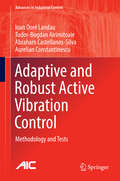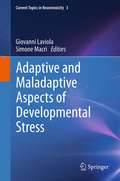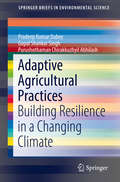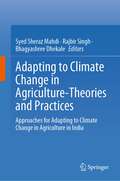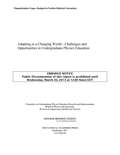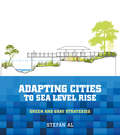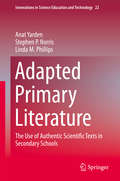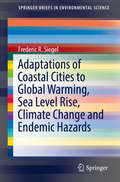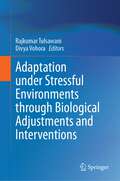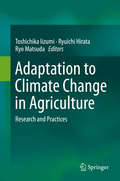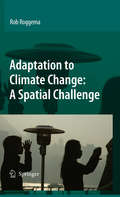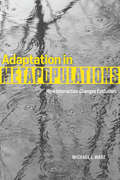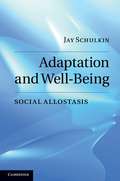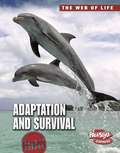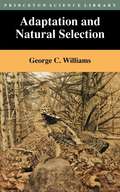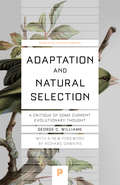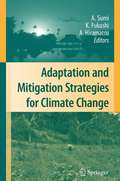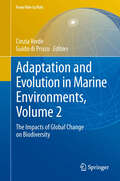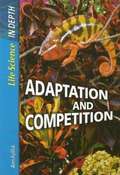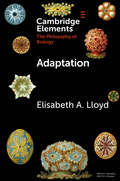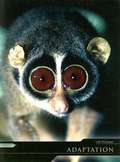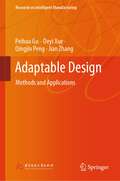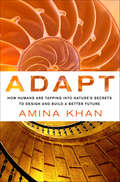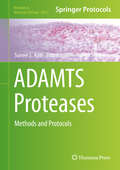- Table View
- List View
Adaptive and Robust Active Vibration Control: Methodology and Tests (Advances in Industrial Control)
by Ioan Doré Landau Tudor-Bogdan Airimițoaie Abraham Castellanos-Silva Aurelian ConstantinescuThis book approaches the design of active vibration control systems from the perspective of today s ideas of computer control. It formulates the various design problems encountered in the active management of vibration as control problems and searches for the most appropriate tools to solve them. The experimental validation of the solutions proposed on relevant tests benches is also addressed. To promote the widespread acceptance of these techniques, the presentation eliminates unnecessary theoretical developments (which can be found elsewhere) and focuses on algorithms and their use. The solutions proposed cannot be fully understood and creatively exploited without a clear understanding of the basic concepts and methods, so these are considered in depth. The focus is on enhancing motivations, algorithm presentation and experimental evaluation. MATLAB(r)routines, Simulink(r) diagrams and bench-test data are available for download and encourage easy assimilation of the experimental and exemplary material. Three major problems are addressed in the book: active damping to improve the performance of passive absorbers;adaptive feedback attenuation of single and multiple tonal vibrations; andfeedforward and feedback attenuation of broad band vibrations. Adaptive and Robust Active Vibration Control will interest practising engineers and help them to acquire new concepts and techniques with good practical validation. It can be used as the basis for a course for graduate students in mechanical, mechatronics, industrial electronics, aerospace and naval engineering. Readers working in active noise control will also discover techniques with a high degree of cross-over potential for use in their field. "
Adaptive and Maladaptive Aspects of Developmental Stress (Current Topics in Neurotoxicity #3)
by Giovanni Laviola Simone MacrìSince the very early stages of life, we all experience some form of stress. Stressors can be mild to severe and can range from unsuccessfully longing for maternal milk in infancy, to recklessly wiggling on a motorbike to be on time to watch the NBA finals on TV, to breaking up a relationship. All those events that we call "stress" have the capability of perturbing a given state of psychological and physiological equilibrium and moving it to a different level. The transition from crawling to walking has to be considered a form of stress as much as losing a job. It is through a continuous cross-talk between environmental stressors and individual adaptations that we build our personalities and our ways to cope with daily hassles. External challenges should not necessarily be regarded as "bad", but instead seen as constructive forces forming our ability to navigate a changing world. What is stress good for? What is stress bad for? When and why do we need to be "stressed"? Should we worry about stress? When does stress equate to "normality"? When does it turn into pathology? We hope with this book to provide some answers to these fundamental questions.
Adaptive Agricultural Practices: Building Resilience in a Changing Climate (SpringerBriefs in Environmental Science)
by Pradeep Kumar Dubey Gopal Shankar Singh Purushothaman Chirakkuzhyil AbhilashThis brief explores several adaptive agricultural practices from around the world to fulfill current and future agricultural demands for food security due to the challenges posed by climate change and growing global population. Readers will discover how farmers adapt to environmental changes by adopting various agronomic practices at crop, farm and landscape levels. Particular attention is given to systemic and transformational adaptation strategies employed by farmers such as mulching, organic farming and crop diversification. This is a highly informative and carefully presented book that provides insights on how crops can build up resilience against periods of drought, high salinity, disasters such as floods, and diseases. The policy implications and future prospects of these adaptation strategies are also addressed. Environmental and plant scientists, agronomists and researchers in climate sciences will find this book interesting.
Adapting to Climate Change in Agriculture-Theories and Practices: Approaches for Adapting to Climate Change in Agriculture in India
by Syed Sheraz Mahdi Rajbir Singh Bhagyashree DhekaleThis book brings together a series of chapters that provides updated information on adaptation practices against climate change in agriculture and livestock. Information on some new aspects like conservation of carnivorous plants, climate-smart millets production, advances in genomic interventions for climate resilient crops, perceptions on disease and pests under changing climate, role of neglected crops in climate resilient agriculture, nanotechnology in sustainable agriculture, use of crop wild relatives for developing climate resilient crops have been discussed. It also presents detailed information carbon sequestration practices and green consumption behaviour for sustainable development. The last chapter of book mentions about an innovative agronomic technique under rainfed conditions for sustainable yield advantage in soybean crop.
Adapting to a Changing World--Challenges and Opportunities in Undergraduate Physics Education
by National Research Council Division on Engineering and Physical Sciences Committee on Undergraduate Physics Education Research and Implementation Board on Physics and AstronomyAdapting to a Changing World was commissioned by the National Science Foundation to examine the present status of undergraduate physics education, including the state of physics education research, and, most importantly, to develop a series of recommendations for improving physics education that draws from the knowledge we have about learning and effective teaching. Our committee has endeavored to do so, with great interest and more than a little passion. The Committee on Undergraduate Physics Education Research and Implementation was established in 2010 by the Board on Physics and Astronomy of the National Research Council. This report summarizes the committee's response to its statement of task, which requires the committee to produce a report that identifies the goals and challenges facing undergraduate physics education and identifies how best practices for undergraduate physics education can be implemented on a widespread and sustained basis, assess the status of physics education research (PER) and discuss how PER can assist in accomplishing the goal of improving undergraduate physics education best practices and education policy.
Adapting Cities to Sea Level Rise: Green and Gray Strategies
by Stefan AlIn 2012, Hurricane Sandy floods devastated coastal areas in New York and New Jersey. In 2017, Harvey flooded Houston. Today in Miami, even on sunny days, king tides bring fish swimming through the streets in low-lying areas. These types of events are typically called natural disasters. But overwhelming scientific consensus says they are actually the result of human-induced climate change and irresponsible construction inside floodplains.As cities build more flood-management infrastructure to adapt to the effects of a changing climate, they must go beyond short-term flood protection and consider the long-term effects on the community, its environment, economy, and relationship with the water. Adapting Cities to Sea Level Rise, by infrastructure expert Stefan Al, introduces design responses to sea-level rise, drawing from examples around the globe. Going against standard engineering solutions, Al argues for approaches that are integrated with the public realm, nature-based, and sensitive to local conditions and the community. He features design responses to building resilience that creates new civic assets for cities. For the first time, the possible infrastructure solutions are brought together in a clear and easy-to-read format.The first part of the book looks at the challenges for cities that have historically faced sea-level rise and flooding issues, and their response in resiliency through urban design. He presents diverse case studies from New Orleans to Ho Chi Minh to Rotterdam, and draws best practices and urban design typologies for the second part of the book. Part two is a graphic catalogue of best-practices or resilience strategies. These strategies are organized into four categories: hard protect, soft protect, store, and retreat. The benefits and challenges of each strategy are outlined and highlighted by a case study showing where that strategy has been applied.Any professional or policymaker in coastal areas seeking to protect their communities from the effects of climate change should start with this book. With the right solutions, Al shows, sea-level rise can become an opportunity to improve our urban areas and landscapes, rather than a threat to our communities.
Adapted Primary Literature: The Use of Authentic Scientific Texts in Secondary Schools (Innovations in Science Education and Technology #22)
by Stephen P. Norris Linda M. Phillips Anat YardenThis book specifies the foundation for Adapted Primary Literature (APL), a novel text genre that enables the learning and teaching of science using research articles that were adapted to the knowledge level of high-school students. More than 50 years ago, J. J. Schwab suggested that Primary Scientific Articles "afford the most authentic, unretouched specimens of enquiry that we can obtain" and raised for the first time the idea that such articles can be used for "enquiry into enquiry". This book, the first to be published on this topic, presents the realization of this vision and shows how the reading and writing of scientific articles can be used for inquiry learning and teaching. It provides the origins and theory of APL and examines the concept and its importance. It outlines a detailed description of creating and using APL and provides examples for the use of the enactment of APL in classes, as well as descriptions of possible future prospects for the implementation of APL. Altogether, the book lays the foundations for the use of this authentic text genre for the learning and teaching of science in secondary schools.
Adaptations of Coastal Cities to Global Warming, Sea Level Rise, Climate Change and Endemic Hazards (SpringerBriefs in Environmental Science)
by Frederic R. SiegelThis book discusses the identification of, solutions to, and management of threats to high population coastal cities and their seaports from global warming, climate change and endemic hazards. These include prevention of sea water intrusion of freshwater coastal aquifers, emplacement of barriers that mitigate the threats from sea level rise, and inundation of urban centers plus those from storm surges that cause flooding and salination of inshore terrain. The book assesses mitigation of the effects of extreme weather events such as drought, and major flooding from heavy rainfall on coastal urban centers, or on associated drainage basins. It also considers how coastal cities can counter vulnerabilities from other physical hazards (e.g., earthquakes - building codes) and health hazards (e.g., pollution, public health response - preparedness) that may be related to a city’s geological/geographical location and service as a port of entry for goods and travelers (regional and international). The book also cites the high costs of safeguarding citizen and municipal assets, but notes possible sources of potential funding especially from less developed and developing nations. The book is written to give strong background information to students majoring in environmental sciences or those in other majors with interests in the effects of global warming/climate change, and will be of interest to social scientists, think tank personnel, government planners, and lay persons in environmentally oriented organizations.
Adaptation under Stressful Environments through Biological Adjustments and Interventions
by Rajkumar Tulsawani Divya VohoraThe book delves into the intricate interplay of stress and adaptive responses, and their multifaceted dynamics influenced by stress type, exposure duration, genetic factors, and lifestyle elements. It unveils the complexity of stress management, unveiling how adaptive strategies evolve in response to stressors. By harnessing scientific breakthroughs in stress response comprehension, the book navigates the path to effective stress mitigation. Through avenues such as pharmacological interventions, dietary adjustments, psychological enhancement, and more, the book advocates for achieving adaptive resilience—a state where the system effectively copes with stress. The text encapsulates an array of stressors, including extreme stress, oxidative stress, and genotoxic stress, dissecting their impact on systemic equilibrium and health. The book's focal point rests on adaptive mechanisms that vary with stressor types, while also spotlighting how these mechanisms can be calibrated through pharmacological and alternative means. This is an invaluable resource for understanding, mitigating, and harnessing the power of adaptation in the face of stress-induced challenges.
Adaptation to Climate Change in Agriculture: Research and Practices
by Toshichika Iizumi Ryuichi Hirata Ryo MatsudaThis book highlights state-of-the-art research and practices for adaptation to climate change in food production systems (agriculture in particular) as observed in Japan and neighboring Asian countries. The main topics covered include the current scientific understanding of observed and projected climate change impacts on crop production and quality, modeling of autonomous and planned adaptation, and development of early warning and/or support systems for climate-related decision-making. Drawing on concrete real-world examples, the book provides readers with an essential overview of adaptation, from research to system development to practices, taking agriculture in Asia as the example. As such, it offers a valuable asset for all researchers and policymakers whose work involves adaptation planning, climate negotiations, and/or agricultural developments.
Adaptation to Climate Change: A Spatial Challenge
by Rob RoggemaAs it becomes clear that climate change is not easily within the boundaries of the 1990's, society needs to be prepared and needs to anticipate future changes due to the uncertain changes in climate. So far, extensive research has been carried out on several issues including the coastal defence or shifting ecozones. However, the role spatial design and planning can play in adapting to climate change has not yet been focused on. This book illuminates the way adaptation to climate change is tackled in water management, ecology, coastal defence, the urban environment and energy. The question posed is how each sector can anticipate climate change by creating spatial designs and plans. The main message of this book is that spatial design and planning are a very useful tool in adapting to climate change. It offers an integral view on the issue, it is capable in dealing with uncertainties and it opens the way to creative and anticipative solutions. Dealing with adaptation to climate change requires a shift in mindset; from a technical rational way of thinking towards an integral proactive one. A new era in spatial design and planning looms on the horizon.
Adaptation in Metapopulations: How Interaction Changes Evolution
by Michael J. WadeAll organisms live in clusters, but such fractured local populations, or demes, nonetheless maintain connectivity with one another by some amount of gene flow between them. Most such metapopulations occur naturally, like clusters of amphibians in vernal ponds or baboon troops spread across the African veldt. Others have been created as human activities fragment natural landscapes, as in stands of trees separated by roads. As landscape change has accelerated, understanding how these metapopulations function--and specifically how they adapt--has become crucial to ecology and to our very understanding of evolution itself. With Adaptation in Metapopulations, Michael J. Wade explores a key component of this new understanding of evolution: interaction. Synthesizing decades of work in the lab and in the field in a book both empirically grounded and underpinned by a strong conceptual framework, Wade looks at the role of interaction across scales from gene selection to selection at the level of individuals, kin, and groups. In so doing, he integrates molecular and organismal biology to reveal the true complexities of evolutionary dynamics from genes to metapopulations.
Adaptation and Well-Being
by Jay SchulkinRecently, an interest in our understanding of well-being within the context of competition and cooperation has re-emerged within the biological and neural sciences. Given that we are social animals, our well-being is tightly linked to interactions with others. Pro-social behavior establishes and sustains human contact, contributing to well-being. Adaptation and Well-Being is about the evolution and biological importance of social contact. Social sensibility is an essential feature of our central nervous systems, and what have evolved are elaborate behavioral ways in which to sustain and maintain the physiological and endocrine systems that underlie behavioral adaptations. Writing for his fellow academics, and with chapters on evolutionary aspects, chemical messengers and social neuroendocrinology among others, Jay Schulkin explores this fascinating field of behavioral neuroscience.
Adaptation and Survival
by Robert SneddenThe book explains how living things develop features to adapt themselves to their environment, improve their chances of survival and also about the natural selection process.
Adaptation and Natural Selection: A Critique of Some Current Evolutionary Thought
by George C. WilliamsBiological evolution is a fact--but the many conflicting theories of evolution remain controversial even today. In 1966, simple Darwinism, which holds that evolution functions primarily at the level of the individual organism, was threatened by opposing concepts such as group selection, a popular idea stating that evolution acts to select entire species rather than individuals. George Williams's famous argument in favor of the Darwinists struck a powerful blow to those in opposing camps. His Adaptation and Natural Selection, now a classic of science literature, is a thorough and convincing essay in defense of Darwinism; its suggestions for developing effective principles for dealing with the evolution debate and its relevance to many fields outside biology ensure the timelessness of this critical work.
Adaptation and Natural Selection: A Critique of Some Current Evolutionary Thought
by George C. Williams Richard DawkinsBiological evolution is a fact—but the many conflicting theories of evolution remain controversial even today. When Adaptation and Natural Selection was first published in 1966, it struck a powerful blow against those who argued for the concept of group selection—the idea that evolution acts to select entire species rather than individuals. Williams’s famous work in favor of simple Darwinism over group selection has become a classic of science literature, valued for its thorough and convincing argument and its relevance to many fields outside of biology. Now with a new foreword by Richard Dawkins, Adaptation and Natural Selection is an essential text for understanding the nature of scientific debate.
Adaptation and Mitigation Strategies for Climate Change
by Ai Hiramatsu Kensuke Fukushi Akimasa SumiIn recent decades there has been a growing awareness of how intricate the interactions are between human beings and the environment. Fortunately, progress has been made in understanding this relationship, and new technologies have been effective in addressing environmental problems. However belatedly, there has been an acknowledgment of the incompatibility of the world's finite resources with humankind's increasingly greater needs for them, and of how such a challenge demands broadened collaboration among engineers, social scientists, politicians and financial powers. Global agreement that the essential issues of the twenty-first century cannot be solved by any one discipline has led to the concept of sustainability. The transdisciplinary contributions selected for inclusion in this book address these concerns with an overview of the diverse fields of study related to sustainability. This collection of work is intended to pave the way for further collaboration among scientists and nations as well.
Adaptation and Evolution in Marine Environments, Volume 1: The Impacts of Global Change on Biodiversity (From Pole to Pole)
by Guido Di Prisco Cinzia VerdeThe poles undergo climate changes exceeding those in the rest of the world in terms of their speed and extent, and have a key role in modulating the climate of the Earth. Ecosystems adapted to polar environments are likely to become vulnerable to climate changes. Their responses allow us to analyse and foresee the impact of changes at lower latitudes. We need to increase our knowledge of the polar marine fauna of continental shelves, slopes and deep sea, as identifying the responses of species and communities is crucial to establishing efficient strategies against threats to biodiversity, using international and cross-disciplinary approaches. The IPY 2007-2009 was a scientific milestone. The outstanding contribution of Marine Biology is reflected in this volume and the next one on "Adaptation and Evolution in Marine Environments - The Impacts of Global Change on Biodiversity" from the series "From Pole to Pole", making these volumes a unique and invaluable component of the scientific outcome of the IPY.
Adaptation and Competition
by Ann FullickThese titles provide an in-depth look at life processes. The books stress key features of science teaching including scientific inquiry, use of ideas and evidence in science, planning, evaluation, and developing investigative skills. Sample experiments and data illustrate best practices in a real context. Case studies of key experiments and discoveries in the history of science are presented as box features (including modern discoveries as well as those with historical importance). Information on the most recent developments in research demonstrates the progressive nature of science.
Adaptation and Change On the Galapagos Islands
by Helen Sillett"The vampire finch and the sneaker iguana have something in common. They both live on the Galapagos Islands, a group of islands in the Pacific Ocean. These islands are a natural wonderland full of strange and amazing birds and animals. Some people have heard about the Galapagos because of the giant tortoises (turtles) that live there. Maybe you have seen these animals in a book or on television. The Galapagos Islands are also famous because of a young man named Charles Darwin, who visited them in 1835. Later, Darwin went on to become one of the most important scientists the world has ever known."-Introduction
Adaptation (Elements in the Philosophy of Biology)
by Elisabeth LloydNatural selection causes adaptation, the fit between an organism and its environment. For example, the white and grey coloration of snowy owls living and breeding around the Arctic Circle provides camouflage from both predators and prey. In this Element, we explore a variety of such outcomes of the evolutionary process, including both adaptations and alternatives to adaptations, such as nonadaptive traits inherited from ancestors. We also explore how the concept of adaptation is used in evolutionary psychology and in animal behavior, and the adequacy of methods used to confirm evolutionary accounts of human traits and behaviors.
Adaptation
by Steve ParkerDiscover how living things adapt to the world around them, creating millions of different species. Explore the fascinating world of living things, including the processes that keep animals and plants alive, and how people study them. Fact boxes that introduce the most amazing plants and animals are featured in this book along with colorful photographs that show the incredible diversity of life. This book includes a glossary and resources for further research. New edition ISBN: 1403488436 (hardcover)
Adaptable Design: Methods and Applications (Research on Intelligent Manufacturing)
by Peihua Gu Deyi Xue Qingjin Peng Jian ZhangThis book provides a comprehensive discussion of Adaptable Design (AD). It covers the conception, method, and application of AD to the real-world product design. AD's benefits are substantial as it upgrades, reuses, remanufactures and recycles products throughout the product lifecycle. It rapidly adapts the existing design in development of new designs. Key elements of AD include rationalized function structures, adaptable product architectures, adaptable interfaces, and adaptability evaluations. The main feature of AD is adaptability in design methods and product applications with general and specific adaptability. AD has also modeling and evaluating adaptabilities.
Adapt: How Humans Are Tapping into Nature's Secrets to Design and Build a Better Future
by Amina KhanAmina Khan believes that nature does it best. In Adapt, she presents fascinating examples of how nature effortlessly solves the problems that humans attempt to solve with decades worth of the latest and greatest technologies, time, and money. Humans are animals too, and animals are incredibly good at doing more with less. If a fly’s eye can see without hundreds of fancy lenses, and termite mounds can stay cool in the desert without air conditioning, it stands to reason that nature can teach us a thing or two about sustainable technology and innovation. In Khan’s accessible voice, these complex concepts are made simple. There is so much we humans can learn from nature’s billions of years of productive and efficient evolutionary experience. This field is growing rapidly and everyone from architects to biologists to nano-technicians to engineers are paying attention. Results from the simplest tasks, creating Velcro to mimic the sticking power of a burr, to the more complex like maximizing wind power by arranging farms to imitate schools of fish can make a difference and inspire future technological breakthroughs.Adapt shares the weird and wonderful ways that nature has been working smarter and not harder, and how we can too to make billion dollar cross-industrial advances in the very near future.
ADAMTS Proteases: Methods and Protocols (Methods in Molecular Biology #2043)
by Suneel S. ApteThis volume provides a variety of methods used to analyze ADAMTS proteases and ADAMTS-like proteins, including their structure, substrate profile, tissue and cell distribution, post-translational modification and biological pathways. Chapters discuss genetic, cell biology, biochemical and proteomics techniques applicable to the analysis of all the members of the ADAMTS superfamily. Written in the highly successful Methods in Molecular Biology series format, chapters include introductions to their respective topics, lists of the necessary materials and reagents, step-by-step, readily reproducible laboratory protocols, and tips on troubleshooting and avoiding known pitfalls. Cutting-edge and thorough, ADAMTS Proteases: Methods and Protocols is a valuable tool for researchers to study both simple and sophisticated methodologies that are often difficult to locate in primary research literature.
